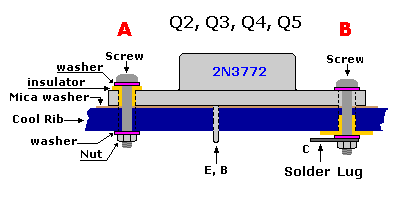McIntosh MC-2100 Amplifier, Power Transistors on Heat Sinks
Typical TO-3 Mounting Hardware Style 1 (screws not shown)
Typical TO-3 Mounting Hardware Style 2
Any well-respected high-end enthusiast will routinely clean off his/her interconnect cable and speaker cable connections with anti-oxidation cleaners; the contact resistance rises as these connections oxidize. That quality sound you once valued begins to fade in proportion to this corrosive effect. A quick cleaning treatment usually restores the music to its previous glory (tube pins and sockets suffer a similar fate).
Taking this contact cleaning thought another step further, I tried something not so drastic as to clean the contacts of these transistors (mine are soldered into the sockets), I merely loosened and re-tightened the mounting screws. You see, the screws are the electrical path for the outer case to the socket and the same oxidation can occur on these as they do on the interconnect cables and such other mechanical switch contacts. A simple twist of the screwdriver to loosen and another to re-tighten knocks off the oxidation enough to make a difference. Of course removing the screws one at a time and cleaning them as you would the interconnect cables is another (better) option but I was in a hurry just to see if my theory was correct.
I am elated to report that the glorious sound of the amp has again returned. The focus within the sound stage is as refined as it ever has been and the depth, width, and height are considerably improved beyond what I recalled it to be at its best. There is also an improvement in the subtle inner detailing of all instruments regardless of frequency and harmonic distribution.
Much like other simple mods I have suggested, this one is pretty simple to do and can change the way your system sounds with little effort. Make sure that the power cord to the amp is unplugged before beginning and wait an hour or so to allow the power supply to totally bleed down before popping off the cover. A screw driver, a wrench, a twist loose, and a twist tight is all that it takes.
The next time I schedule my amp for downtime (the main supply capacitors are starting to show signs of hum), I will indeed remove the screws and clean them properly. But for now, I cannot believe how just this simple fix has rejuvenated the sound of this amplifier. I would highly recommend having this don to your amp too.
Yours for higher fidelity,
Philip Rastocny
Skeptics are essential to keep us sane; skeptics do little to keep us inspired. Philip Rastocny, 7-16-2014
Skeptics are essential to keep us sane; skeptics do little to keep us inspired. Philip Rastocny, 7-16-2014
I do not use ads in this blog to help support my efforts. If you like what you are reading, please remember to reciprocate, My newest title is called Where, oh Where did the Star of Bethlehem Go? It’s an astronomer’s look at what this celestial object may have been, who the "Wise Men" were, and where they came from. Written in an investigative journalism style, it targets one star that has never been considered before and builds a solid case for its candidacy.
My other titles include:
Copyright © 2015 by Philip Rastocny. All rights reserved.







